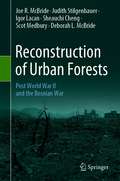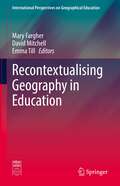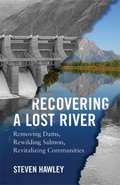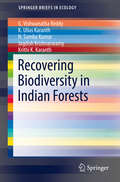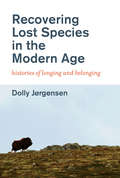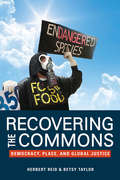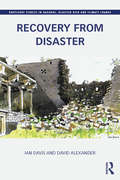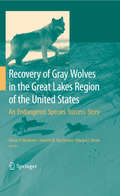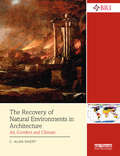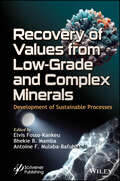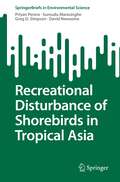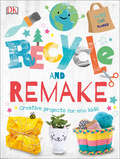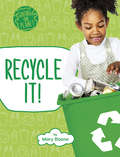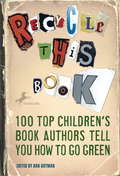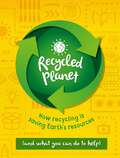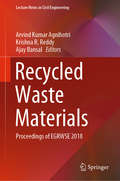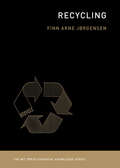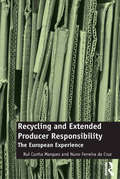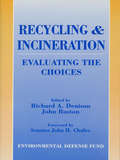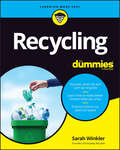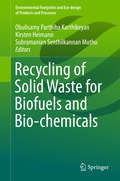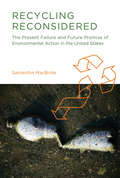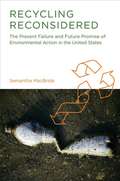- Table View
- List View
Reconstruction of Urban Forests: Post World War II and the Bosnian War
by Joe R. McBride Judith Stilgenbauer Igor Lacan Sheauchi Cheng Scot Medbury Deborah L. McBrideThis book will address the destruction of urban forest in nine cities by bombing during World War II and the Bosnian War and their reconstruction in the post-war years. After reviewing the general objectives and results of aerial bombing, the book explores the effects of bombing and the reconstruction of urban forest in London, Coventry, Hamburg, Dresden, St. Petersburg, Stalingrad, Tokyo, Hiroshima, and Sarajevo. Sarajevo stands out among these cities because the destruction of its urban forest was the result of citizens cutting down trees for firewood during the siege of the city. Most of the cities studied developed plans for reconstruction either during or after the war. These plans often addressed the planning and re-establishment of the urban forest that had been destroyed. Urban planners often planned for infrastructure improvements such as new boulevards and parks where trees would be planted. After the war many of these plans were abandoned or significantly modified. Cost, resistance by property owners, control of reconstruction by authorities outside of the cities, and the lack of planting stock were factors contributing to the failure of many of the plans. Exceptions occurred in Hiroshima and Coventry where the destroyed cities became symbols of national reconstruction and every effort was made to redesign the destroyed portions of these cities as memorials to those who lost their lives and to demonstrate the rebirth of the cities. In several of the cities studied individual citizens undertook on their own the replanting of street and park trees. Their ingenuity, hard work, and dedication to trees in their cities was remarkable. A common factor limiting efforts to replant street and park trees was the lack of nursery stock. During and immediately after the wars nearly all nurseries that had supplied trees for city planting had been converted to vegetable gardens to produce food for the urban populations. The slow return to the production of trees for urban planting was a common factor in the time required in many cities to restore their street and park trees. There are lessons to be learned by urban planner, urban forester, and landscape architects from this book that will be useful in the future destruction of urban forest either by natural or man-made causes.
Recontextualising Geography in Education (International Perspectives on Geographical Education)
by Mary Fargher David Mitchell Emma TillIn this book international geography educators discuss the ways in which geographical knowledge is recontextualised in schools and consider effective approaches to facilitate, improve and advance geography education in research and practice. It addresses key topics in recontextualising geography such as the epistemic relationships between the university discipline and the school subject, designing and evaluating the geography curriculum, the role of students in the transformation of knowledge in the classroom and selecting and transforming geographical content knowledge for the primary school curriculum. At an international level, the contributors and editors bring together an advanced collection of research and discussion surrounding the opportunities and challenges of recontextualising geography in education. The book is of interest to geography educators internationally, including academics at universities, teachers in schools, and professional geographers with an interest in education.
Recovering a Lost River: Removing Dams, Rewilding Salmon, Revitalizing Communities
by Steven HawleyA powerful argument for why dam removal makes good scientific, economic, and environmental sense-and requires our urgent attention In the Pacific Northwest, the Snake River and its wilderness tributaries were once some of the world#x19;s greatest salmon rivers. As recently as a half century ago, they retained some of their historic bounty, with millions of fish returning to spawn. Now, due to four federal dams, the salmon population has dropped close to extinction. Efforts at salmon recovery through fish ladders, hatcheries, and even trucking them over the dams have failed. Steven Hawley, journalist and self-proclaimed #x1C;river rat,#x1D; argues that the best hope for the Snake River lies in dam removal, a solution that pits the power authorities and Army Corps of Engineers against a collection of Indian tribes, farmers, fishermen, and river recreationists. The river#x19;s health, as he demonstrates, is closely connected to local economies, fresh water rights, energy independence-and even the health of orca whales in Puget Sound. The story of the Snake River, its salmon, and its people raises the fundamental questions of who should exercise control over natural resources and which interests should receive highest priority. It also offers surprising counterpoints to the notion of hydropower as a cheap, green, and reliable source of energy, and challenges the wisdom of heavily subsidized water and electricity. This regional battle is part of an ambitious river restoration movement that stretches across the country from Maine#x19;s Kennebec to California#x19;s Klamath, and engages citizens from a broad social spectrum. In one successful project, the salmon of Butte Creek rebounded from a paltry fourteen fish to twenty thousand within just a few years of rewilding their river, showing the incredible resiliency of nature when given the slightest chance. Recovering a Lost River depicts the compelling arguments and actions being made on behalf of salmon by a growing army of river warriors. Their message, persistent but disarmingly simple, is that all salmon need is water in their rivers, and a clear way home.
Recovering Biodiversity in Indian Forests
by G. Vishwanatha Reddy K. Ullas Karanth N. Samba Kumar Jagdish Krishnaswamy Krithi K. KaranthThis book demonstrates how varying levels of human disturbance manifested through different management regimes influence composition, richness, diversity and abundance of key mammal, bird and plant species, even within ecologically similar habitats. Based on our results, we show the critical importance of the 'wildlife preservation' approach for effective biodiversity conservation. The study also provides examples of a practical application of rigorous methods of quantitative sampling of different plant and animal taxa as well as human influences, thus serving as a useful manual for protected area managers. Protectedareas of various kinds have been established in India with the goal ofarresting decline in, and to provide for, recovery of biodiversity andecosystem services. A model that targets 'wildlife preservation' under stateownership is practiced across the country. However, forests in India are underintensive human pressure and varying levels of protection; therefore, protectedareas may also experience open-access resource use, a model that is beingaggressively advocated as a viable alternative to 'preservationism'. We haveevaluated the conservation efficacy of alternative forest management models byquantifying levels of biodiversity under varied levels of access, resourceextraction and degree of state-sponsored protection in the Nagarahole forestlandscape of southwestern India.
Recovering Lost Species in the Modern Age: Histories of Longing and Belonging (History for a Sustainable Future)
by Dolly JorgensenA groundbreaking study of how emotions motivate attempts to counter species loss. This groundbreaking book brings together environmental history and the history of emotions to examine the motivations behind species conservation actions. In Recovering Lost Species in the Modern Age, Dolly Jørgensen uses the environmental histories of reintroduction, rewilding, and resurrection to view the modern conservation paradigm of the recovery of nature as an emotionally charged practice. Jørgensen argues that the recovery of nature—identifying that something is lost and then going out to find it and bring it back—is a nostalgic practice that looks to a historical past and relies on the concept of belonging to justify future-oriented action. The recovery impulse depends on emotional responses to what is lost, particularly a longing for recovery that manifests itself in such emotions as guilt, hope, fear, and grief. Jørgensen explains why emotional frameworks matter deeply—both for how people understand nature theoretically and how they interact with it physically. The identification of what belongs (the lost nature) and our longing (the emotional attachment to it) in the present will affect how environmental restoration practices are carried out in the future. A sustainable future will depend on questioning how and why belonging and longing factor into the choices we make about what to recover.
Recovering the Commons: Democracy, Place, and Global Justice
by Herbert Reid Betsy TaylorThis penetrating work culls key concepts from grassroots activism to hold critical social theory accountable to the needs, ideas, and organizational practices of the global justice movement. The resulting critique of neoliberalism hinges on place-based struggles of groups marginalized by globalization and represents a brave rethinking of politics, economy, culture, and professionalism. Providing new practical and conceptual tools for responding to human and environmental crises in Appalachia and beyond, Recovering the Commons radically revises the framework of critical social thought regarding our stewardship of the civic and ecological commons. Herbert Reid and Betsy Taylor ally social theory, field sciences, and local knowledge in search of healthy connections among body, place, and commons that form a basis for solidarity as well as a vital infrastructure for a reliable, durable world. Drawing particularly on the work of philosophers Maurice Merleau-Ponty, John Dewey, and Hannah Arendt, the authors reconfigure social theory by ridding it of the aspects that reduce place and community to sets of interchangeable components. Instead, they reconcile complementary pairs such as mind/body and society/nature in the reclamation of public space. With its analysis embedded in philosophical and material contexts, this penetrating work culls key concepts from grassroots activism to hold critical social theory accountable to the needs, ideas, and organizational practices of the global justice movement. The resulting critique of neoliberalism hinges on place-based struggles of groups marginalized by globalization and represents a brave rethinking of politics, economy, culture, and professionalism.
Recovery from Disaster (Routledge Studies in Hazards, Disaster Risk and Climate Change)
by David Alexander Ian DavisDisasters can dominate newspaper headlines and fill our TV screens with relief appeals, but the complex long-term challenge of recovery—providing shelter, rebuilding safe dwellings, restoring livelihoods and shattered lives—generally fails to attract the attention of the public and most agencies. On average 650 disasters occur each year. They affect more than 200 million people and cause $166 trillion of damage. Climate change, population growth and urbanisation are likely to intensify further the impact of natural disasters and add to reconstruction needs. Recovery from Disaster explores the field and provides a concise, comprehensive source of knowledge for academics, planners, architects, engineers, construction managers, relief and development officials and reconstruction planners involved with all sectors of recovery, including shelter and rebuilding. With almost 80 years of first-hand experience of disaster recovery between them, Ian Davis (an architect) and David Alexander (a geographer) draw substantially from first-hand experiences in a variety of recovery situations in China, Haiti, Italy, Japan, New Zealand, Pakistan, the Philippines and the USA. The volume is further enriched by two important and unique features: 21 models of disaster recovery are presented, seven of which were specifically developed for the book. The second feature is a survey of expert opinion about the nature of effective disaster recovery—the first of its kind. More than 50 responses are provided in full, along with an analysis that integrates them with the theories that underpin them. By providing a framework and models for future study and applications, Davis and Alexander seek both to advance the field and to provide a much-needed reference work for decision makers. With a broad perspective derived from the authors' roles held as university professors, researchers, trainers, consultants, NGO directors and advisors to governments and UN agencies, this comprehensive guide will be invaluable for practitioners and students of disaster management.
Recovery of Gray Wolves in the Great Lakes Region of the United States: An Endangered Species Success Story
by Adrian P. Wydeven Edward Heske Timothy R. DeelenThe Great Lakes region is unique in that it is the only portion of the lower 48 states where wolves were never extirpated. As the birthplace of some of the first modern concepts of wolf conservation and research, the region is also the first place in the U.S. where "endangered" wolf populations recovered. During this process, much has been learned about wolf biology and ecology, endangered species management, carnivore conservation, landscape ecology, depredation management, and social aspects of wildlife conservation. Recovery of Gray Wolves in the Great Lakes Region of the United States traces wolf recovery in this region and highlights lessons learned by conservationists during the recovery process. Each chapter includes a thorough review of the pertinent literature, in addition to new data and new perspectives and interpretations. The result is both rigorous with respect to science and policy and accessible and interesting for the lay reader. The story of wolf recovery in the Great Lakes region is one of international significance for conservationists.
The Recovery of Natural Environments in Architecture: Air, Comfort and Climate (Building Research and Information)
by C. Alan ShortThe Recovery of Natural Environments in Architecture challenges the modern practice of sealing up and mechanically cooling public scaled buildings in whichever climate and environment they are located. This book unravels the extremely complex history of understanding and perception of air, bad air, miasmas, airborne pathogens, beneficial thermal conditions, ideal climates and climate determinism. It uncovers inventive and entirely viable attempts to design large buildings, hospitals, theatres and academic buildings through the 19th and early 20th centuries, which use the configuration of the building itself and a shrewd understanding of the natural physics of airflow and fluid dynamics to make good, comfortable interior spaces. In exhuming these ideas and reinforcing them with contemporary scientific insight, the book proposes a recovery of the lost art and science of making naturally conditioned buildings.
Recovery of Values from Low-Grade and Complex Minerals: Development of Sustainable Processes
by Elvis Fosso-Kankeu Bhekie B. Mamba Antoine F. Mulaba-BafubiandiRecovery of Values from Low-Grade and Complex Minerals The book elaborates on various physicochemical properties of minerals and technological developments to improve the recovery of metals while ensuring cost-effectiveness and minimal environmental impact. The mineral industry is undergoing significant cultural, organizational, and technological transformations to address some of the major limitations and challenges related to the environmental and productivity domains. As far as productivity is concerned, the decrease of high-grade ores has been one of the stumbling blocks toward the achievement of maximum recovery of metals while, on the other hand, the complexity of minerals therein makes it difficult to profitably extract metals using only conventional methods. This book presents eight specialized chapters that focus on the exploration of the complexity of minerals that are likely to negatively influence the recovery of values, as well as the development of adequate technologies capable of improving the process of mineral concentration and/or metal recovery from complex minerals in a sustainable manner. It reviews the various physicochemical properties of minerals that are likely to pose a challenge during the attempt to recover values using conventional methods. It also elaborates on the recent technological development that has been considered by researchers to improve the recovery of metals from gangue-dominated minerals while ensuring cost-effectiveness and minimal adverse environmental impact. Audience This book will be of interest to academic researchers from the fields of mineral processing, hydrometallurgy, geochemistry, environment, chemistry, engineering, and professionals including mining plant operators, environmental managers in the industries, government regulatory bodies officers, and environmentalists.
Recreational Disturbance of Shorebirds in Tropical Asia (SpringerBriefs in Environmental Science)
by Priyan Perera Sumudu Marasinghe Greg D. Simpson David NewsomeMuch of that growing demand for coastal recreation and tourism has focused on countries in South and Southeast Asia in the tourism megaregion that this book refers to as Tropical Asia. As such, the recreational disturbance of shorebirds in Asia is a serious conservation issue, at a time when populations of both migratory and non-migratory species of shorebirds are threatened and declining because of the loss of coastal habitat and increased human disturbance. Despite global awareness about the impacts that the growth of coastal recreation and tourism across Tropical Asia is likely to be having on threatened and endangered migratory and resident shorebird species of the coastal zones of the East Asian– Australasian Flyway, less than 3% of the published peer-reviewed research into the recreational disturbance of shorebirds addresses coastal zones of Tropical Asia. This situation points to a significant knowledge gap regarding the impacts of human recreation on shorebirds in the Tropical Asian region. In contrast, almost three quarters of the peer-reviewed articles that report recreational disturbance research and management strategies focus on coastal zones in North America (36%), Oceania (20%), and Europe (20%). For those reasons, the quantitative systematic literature review and research case study from Sri Lanka reported in this book provide a call to action and recommendations for both management approaches grounded in the international literature and a research agenda that should be implemented in the coastal zones of Tropical Asia.
Recycle and Remake: Creative Projects for Eco Kids
by DKKids are on a mission to save the Earth! Recycle and Remake is the hands-on, practical guide they need to get started.This gentle, but empowering book is full of creative making activities, information, and ideas that give young eco-warriors the know-how to really help the environment. With Recycle and Remake, kids will soon be saving trees by making their own seeded recycled paper from junk mail, cleaning up the oceans by turning old shopping bags into kites, friendship bracelets, and colorful woven baskets, and repurposing a cardboard box into a periscope. They'll also learn about sustainable energies by creating a simple solar oven, cutting down on plastic wrap by making a food wrap from scrap cotton and beeswax, and turning an old tee shirt into a reusable tote bag. They can even grow new plants to clean the air in their own upcycled milk bottle planters and using homemade compost.As kids make and create, they will learn kid-friendly facts about the big issues our planet is facing. Each of the activities directly relates to an environmental hot topic, such as plastic pollution, food waste, or deforestation. Budding environmentalists all over the world are feeling inspired to do their part for our amazing planet. This future-friendly book is here to guide them with all the information, ideas, tips, and tools they need to be part of the solution.
Recycle It! (Saving Our Planet)
by Mary BooneIntroduces early readers to environmentalist concepts including recycling and composting, and what they can do to help the environment. Features real-life examples of kids who have made a difference.
Recycle this Book
by Dan GutmanWith essays from renowned children's book authors such as Ann Brashares, Jeanne DuPrau, Caroline B. Cooney, Laurie Halse Anderson, Bruce Coville, Gennifer Choldenko, and over 100 others, each piece is an informative and inspiring call to kids of all ages to understand what's happening to the environment, and to take action in saving our world.Helpful tips and facts are interspersed throughout. This book will be a great classroom tool to teach young readers how they can help to make the Earth a greener place.From the Trade Paperback edition.
Recycled Planet
by Anna ClaybourneRecycled Planet explains to young readers how essential recycling is in today's worldRecycling is part of everyday life today. From food scraps to mobile phones, recycling gives many materials a new lease of life and prevents them from polluting our planet, as well as saving energy.Recycled Planet explores the world of recycling, looking at what we recycle, how it is collected and separated and what happens during the recycling process. It also looks at new forms of recycling, from deposit schemes to repurposing, and assesses some innovations designed to make recycling more global and efficient. Simple activities encourage readers to take part in recycling themselves and to aim to recycle even more!Following on from Plastic Planet and Hot Planet, Recycled Planet will feature the same blend of illustrations and photos and a striking cover, and is written by the award-winning science author Anna Claybourne.Aimed at readers aged 9 plus.
Recycled Waste Materials: Proceedings of EGRWSE 2018 (Lecture Notes in Civil Engineering #32)
by Arvind Kumar Agnihotri Krishna R. Reddy Ajay BansalThis volume contains selected papers presented during the International Conference on Environmental Geotechnology, Recycled Waste Material and Sustainable Engineering (EGRWSE-2018). The papers focus on finding innovative ways of recycling and reusing waste materials, reducing demand for natural resources and processing industrial and chemical wastes such that disposal reduces their environmental burden. This volume will be of interest to researchers, policy makers and practitioners working in the field of waste management.
Recycling (The MIT Press Essential Knowledge Series)
by Finn Arne JorgensenAn overview of recycling as an activity and a process, following different materials through the waste stream.Is there a point to recycling? Is recycling even good for the environment? In this volume in the MIT Press Essential Knowledge series, Finn Arne Jørgensen answers (drumroll, please): it depends. From a technical point of view, recycling is a series of processes—collecting, sorting, processing, manufacturing. Recycling also has a cultural component; at its core, recycling is about transformation and value, turning material waste into something useful—plastic bags into patio furniture, plastic bottles into T-shirts. Jørgensen offers an accessible and engaging overview of recycling as an activity and as a process at the intersection of the material and the ideological. Jørgensen follows a series of materials as they move back and forth between producer and consumer, continually transforming in form and value, in a never-ceasing journey toward becoming waste. He considers organic waste and cultural contamination; the history of recyclable writing surfaces from papyrus to newsprint; discarded clothing as it moves from the the Global North to the Global South; the shifting fate of glass bottles; the efficiency of aluminum recycling; the many types of plastic and the difficulties of informed consumer choice; e-waste and technological obsolescence; and industrial waste. Finally, re-asking the question posed by John Tierney in an infamous 1996 New York Times article, “is recycling garbage?” Jørgensen argues that recycling is necessary—as both symbolic action and physical activity that has a tangible effect on the real world.
Recycling and Extended Producer Responsibility: The European Experience
by Rui Cunha Marques Nuno Ferreira CruzAn overriding value of European legislation on waste management is the Extended Producer Responsibility (EPR) principle. For example, all economic operators placing packaging onto the EU market are responsible for its proper management and recovery. However, in general, the collection and treatment of urban waste is the responsibility of local authorities. It has therefore been necessary to establish a system of financial compensations between producers and waste management operators. Analysing the legal and institutional schemes of several member states and accounting for all the costs and benefits to their local authorities due to selective collection and sorting, this book provides an accurate illustration of how the EPR principle has be translated into practice. Firstly the authors examine whether the industry is paying for the net financial cost of 'preparation for recycling' activities or if the extra-costs of recycling are being recovered via the sale of sorted materials, by the consumer through higher prices or by citizens in general through higher taxes. Secondly, by monetizing the net environmental benefits attained with the recycling system, the book discusses the success and Value-for-Money (VfM) of the EU’s recycling policy. In other words: what is the economic rate of return of the enhanced environmental protection achieved due to the fulfilment of recovery and recycling targets?
Recycling and Incineration: Evaluating The Choices
by John Ruston Richard Denison Environmental Defense FundRecycling and Incineration presents information on the technology, economics, environmental concerns, and legal intricacies behind recycling and incineration programs.
Recycling For Dummies
by Sarah WinklerLearn the facts about recycling and discover the best way to make an impact Recycling is a simple action we can take that has an immediate positive effect. It keeps waste out of landfills, conserves natural resources, prevents pollution, and saves energy. Who wouldn’t want to do this? But recycling isn’t always straightforward. With so many different rules, it can be tough to work out the right thing to do. If you’re worried that you’re not recycling properly, or wondering whether you could be recycling more, this is the book for you. Recycling For Dummies cuts through the confusion around what you can and can’t recycle. This easy-to-follow manual breaks down recycling codes, symbols, and rules in a straightforward way that anyone can understand and apply. You’ll gain insight into the recycling process (where does that stuff go, anyway?) and learn tons of tips on reusing items in your daily life to cut down on waste. It also guides you on how to make smarter choices as a consumer to help preserve the planet for generations to come. Figure out what common materials can and can’t be recycled Understand what the recycling symbols are telling you Explore the many specialist recycling services available Learn what happens to your recyclables after they get picked up Become a true recycler by switching to recycled productsCheck out this book if you want to make your efforts count and be part of the recycling solution.
Recycling of Solid Waste for Biofuels and Bio-chemicals
by Obulisamy Parthiba Karthikeyan Kirsten Heimann Subramanian Senthilkannan MuthuThis book presents the latest advances in and current research perspectives on the field of urban/industrial solid waste recycling for bio-energy and bio-fuel recovery. It chiefly focuses on five main thematic areas, namely bioreactor landfills coupled with energy and nutrient recovery; microbial insights into anaerobic digestion; greenhouse emission assessment; pyrolysis techniques for special waste treatment; and industrial waste stabilization options. In addition, it compiles the results of case studies and solid waste management perspectives from different countries.
Recycling Reconsidered: The Present Failure and Future Promise of Environmental Action in the United States (Urban and Industrial Environments)
by Samantha MacbrideHow the success and popularity of recycling has diverted attention from the steep environmental costs of manufacturing the goods we consume and discard.Recycling is widely celebrated as an environmental success story. The accomplishments of the recycling movement can be seen in municipal practice, a thriving private recycling industry, and widespread public support and participation. In the United States, more people recycle than vote. But, as Samantha MacBride points out in this book, the goals of recycling—saving the earth (and trees), conserving resources, and greening the economy—are still far from being realized. The vast majority of solid wastes are still burned or buried. MacBride argues that, since the emergence of the recycling movement in 1970, manufacturers of products that end up in waste have successfully prevented the implementation of more onerous, yet far more effective, forms of sustainable waste policy. Recycling as we know it today generates the illusion of progress while allowing industry to maintain the status quo and place responsibility on consumers and local government.MacBride offers a series of case studies in recycling that pose provocative questions about whether the current ways we deal with waste are really the best ways to bring about real sustainability and environmental justice. She does not aim to debunk or discourage recycling but to help us think beyond recycling as it is today.
Recycling Reconsidered
by Samantha MacbrideRecycling is widely celebrated as an environmental success story. The accomplishments of the recycling movement can be seen in municipal practice, a thriving private recycling industry, and widespread public support and participation. In the United States, more people recycle than vote. But, as Samantha MacBride points out in this book, the goals of recycling -- saving the earth (and trees), conserving resources, and greening the economy -- are still far from being realized. The vast majority of solid wastes are still burned or buried. MacBride argues that, since the emergence of the recycling movement in 1970, manufacturers of products that end up in waste have successfully prevented the implementation of more onerous, yet far more effective, forms of sustainable waste policy. Recycling as we know it today generates the illusion of progress while allowing industry to maintain the status quo and place responsibility on consumers and local government. MacBride offers a series of case studies in recycling that pose provocative questions about whether the current ways we deal with waste are really the best ways to bring about real sustainability and environmental justice. She does not aim to debunk or discourage recycling but to help us think beyond recycling as it is today.
Recycling (World About Us)
by Tony HareDiscusses methods of recycling metal, plastic, paper, and glass, and why such conservation efforts are important.
Recyclo-gami: 40 Crafts to Make your Friends GREEN with Envy!
by Laurie Goldrich WolfWhat can you make out of your old bits of paper, leftover pieces of yarn, or not-so-brand-new cartons and containers? Craft your own purse out of playing cards, whip up a scrapbook made of cereal boxes, or a dollhouse from an empty juice carton! Tweens and teens can start crafting using the easy to follow instructions and photographic directions the smart way. All crafts are made out of materials that many of us find just lying around the house or sitting on the curb waiting to be tossed in a landfill. Overpriced décor, fashion, and gifts are out, and recyclable crafts are in!
